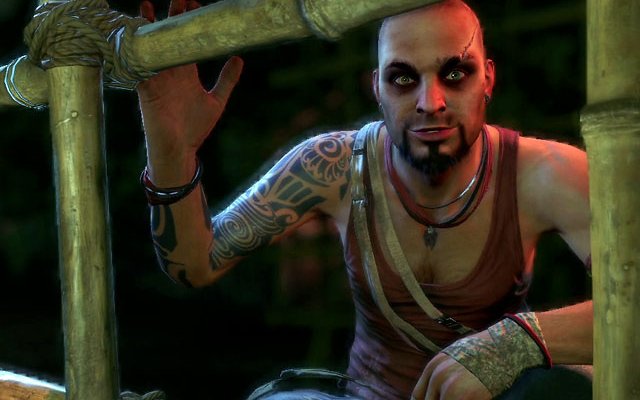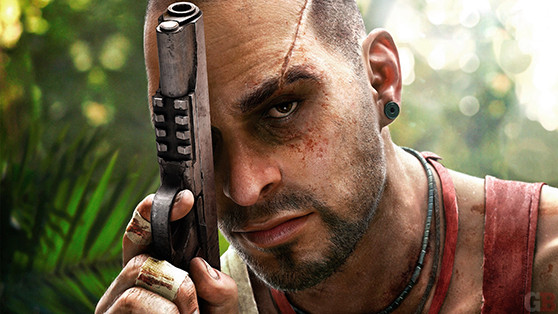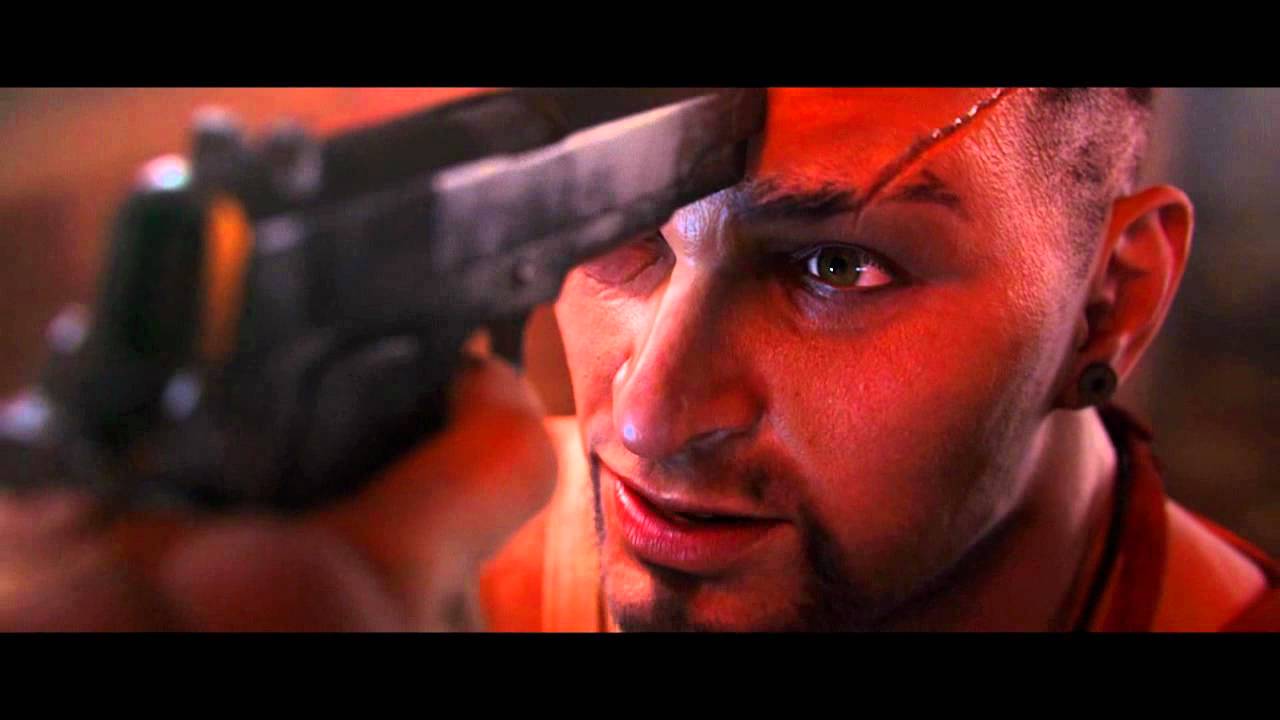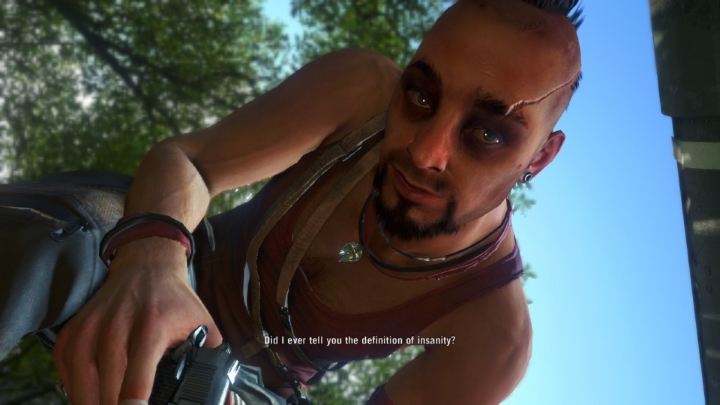Did he ever tell you what the definition of insanity is?
Vaas Montenegro, the primary antagonist of Far Cry 3, is one of the most enduring and well-remembered villains from recent video game history. He frequents many a top-10 list of bad guys, and general consensus from gaming communities is that he’s the strongest and most revered villain in the Far Cry franchise, maybe even of any of Ubisoft’s titles. More than the traditional psychopathic stereotype, Vaas is a villain in every conceivable sense, but the way Ubisoft created him goes beyond what’s expected within the medium. So why has Vaas developed such a sway over our collective memories? Why has his character become such a phenomenon of our evildoer consciousness?

An engaging big bad
(Warning: Spoilers ahead)
Far Cry 3 opens with Vaas in the most dramatic way possible, establishing him early on with the clear psyche of a ruthless killer, kidnapper, and torturer. However, rather than the early segments demonstrating this superficially, we get an insight into his thinking and his neurotic mindset, enough to pique our interest without ever telegraphing his actual intentions. More importantly, though, he isn’t just presented as a cold or bland murderer. Vaas is immediately portrayed as an unnerving but ultimately engaging and enthralling personality, brought to life by some incredibly believable acting and dialogue. He’s given the capacity to control a scene, and actor Michael Mando does an exquisite job of taking your awareness and throttling it until you pay him every ounce of attention he deserves with the kind of confidence and swagger we associate with the highest of society.
His character is so effective because he is always portrayed as the dominating force in any scene. You’re under his spell, living within his rules and according to whatever whim he dictates for you. As players, we are always off-guard, and that’s so incredibly exciting. A similar example is that of Ramsey Bolton, for those familiar with Game of Thrones. Ramsey is similar in character type, and he was also a personal favorite of mine throughout the show due to his ability to steal entire scenes, shock you with every action he took, and astound you with each dastardly deed he enacted. He was unpredictable, he was unsettling, and he was surprising — all components that allow for moments that can equally horrify and delight you as a viewer or player. Vaas is cast from the same mold and takes on the mantle of psychopathic maniac in all the best ways.
It would be wrong to assume that Vaas does heinous actions simply for the sake of doing so, however. Ubisoft managed to avoid that tricky problem of using violent actions simply for the sake of them, instead using those actions as a means of exposition to develop his overall personality and backstory. Take the scene in the hut where you are swiftly taken hostage, Vaas spewing gasoline all around before dissecting his rather complicated relationship with his sister. We learn he only started killing for the sake of his family, his rage and anger overflowing as he loudly exclaims, “Them or me? Me or them?” while he beats his chest. Our antagonist clearly has a damaged and malfunctioning psyche, but can we truly trust his stated motivations for what he’s doing? The destructive nature of his violent acts means we can never tell if he does things because he has no inhibition, or if it’s driven by this aforementioned psychological issue that’s been deep-rooted within him. We as players are left wondering and questioning, without the ability to effectively empathize.
When lacking empathy works
Empathy is a largely universal human trait, demonstrable across the majority of the spectrum of our species, with a minority being the exception. Generally, empathy is considered the way in which human beings connect with one another. More importantly, it’s a crucial mechanism developers use to create a link between the player and their antagonist or protagonist. That’s what makes Vaas such a peculiar paradox to this norm.
As players, we generally connect and are enthralled by Vaas’ character precisely because we can’t empathize with his personality, morality, or rationale. For example, with other Far Cry villains, such as Hoyt, Pagan Min, or even the newly introduced Joseph Seed, we can at least empathize with their point of views to a very particular extent. This actually allows us as players to use our theory of mind to debunk and challenge their rationale with our own and to compare it against the “heroic” actions of our avatar. These other Far Cry villains also had more redeemable and sympathetic aspects to their characters; for example, Pagan Min effectively dropping everything at the end of Far Cry 4 to give to Ajay. Vaas, however, has very few or none of these qualities that are on display during our time with him.
We can’t understand his mindset, we can’t sympathize with his motivations, and we can’t use theory of mind or empathy to create a connection with him. He’s an enigma, something completely outside of our “normal” expectations. This feeds the aforementioned unpredictability of his actions. If we cannot appreciate his inner workings, his moral compass (or lack thereof), then we cannot predict or anticipate what he’s next going to subject us to. He’s not simply a “psycho” for the sake of being psychopathic; it’s a foundation from which to establish an entity we’re unlikely to have ever come across in real life or in most other games. This allowed the developers to build up an intrigue and mystery surrounding Vaas, keeping players off-balance, on edge and yet itching for the next encounter.
These encounters are brief, intensely visceral, and deeply intimate. Vaas fills the screen and reaches right into the depths of the psychopathic psyche. But these instances are short-lived and relatively abrupt, quickly ending with a shake of his fist or a bullet from his chamber. By keeping things rapid and succinct, we’re always desperate to see more of his evil: vile but exciting, devastating but impressive, horrifying but intriguing. We as players can usually never get enough of the action, so by limiting it to effectively small snippets of adrenaline, the player becomes spurred and motivated to push on, and Vaas never overstays his welcome or becomes boring or repetitive.
Using anger to develop, not define
Earlier it was established that Vaas clearly has an innate predisposition towards anger and rage. We witness him commit some rather vicious actions during our time with him, either in cutscenes or dialogue. However, Vaas isn’t simply portrayed as an angry man or a raging bull; at times, he’s shown to be a cool-minded, tapered, and efficient villain, capable of the worst crimes but with little emotional resonance. This gives us as players — and our protagonist — the sense that Vaas isn’t just a hate-inspired being and that he’s a more sinister form of evil than sheer fury. Take the example of Kratos from the God of War series — the epitome of the angry game character. Very few people relate to Kratos or expect anything other than anger, whereas with Vaas, we can predict we’re going to witness some form of violence, but we lack any expectation of how he is going to deliver it.
Put simply, if a villain is formed only by his innate and feral desire to be angry, the character will become far too one-dimensional to remain interesting or enjoyable. As with any character, in real life or in virtual, people need to be multi-faceted, a combination of traits that create a more holistic form. For Vaas, anger forms one of these facets. At times, he releases his fury, and at others, he controls it, condenses it, and applies it into something much more sinister and intimidating. The intimate moments when you’re locked up, surrendered to his grasp, are when he can demonstrate this most effectively. This is most noticeable in your first scene with him, trapped in the cage, or when he’s pouring petrol over you and popping finger guns against his head.
Not just another monologue
One of the recent issues raised with the newly released Far Cry 5 is that its primary bad guys only talk at you, reeling off their motivations like checklists, without any real interaction to demonstrate the desires that drive them. This was also something I personally found to be a problem with Far Cry 4‘s Pagan Min, who seemed to be defined by his colorful suit and willingness to spew dialogue at you, without any background behavior to flesh out his intriguing personality.
On the flip side of this, Vaas generally combines action with dialogue, whether it be toying with you to run from him (“Run, Forrest, run!”) or having his goons send people spiraling down a waterfall to a gripping death via drowning — all the while chillingly divulging what the definition of insanity is. Even at his end, drugging you, chastising you, and baiting you in to finally end him, he never relents or relinquishes to you up to his last moment, where he begs you to finish the job you started.
But more than just this fusion of brutal action and gratifying dialogue, Vaas also directly influences and develops both Jason as the protagonist and we as the players. We descend further into the island, wiping out dozens of thugs in outposts, taking up more and more lethal weaponry, mastering our own inner abilities to become relentless, seething killers with no remorse for the lives we butcher in order to finally get our vengeance. Vaas’ character helps to define and create our own, as we build up our understanding of the location, master new abilities, and make ourselves powerhouses to match his killing efficiency. He successfully transforms Jason into a murderer, a fellow slayer built in his own image — just with less grace with words. This can all be seen by the final choice at the end, where selecting the “bad” ending completes Jason’s descent into the darkness he started out with so much intent to end.
The use of Vaas’ catchphrase is not just there to give him something easily memorable. It’s there to show how we as players continue to do the same things (killing, butchering, murdering) over and over again, expecting things to change, to become better, more idyllic. Then when Vaas is finally gone, we still continue on our carnage-fueled rampage, barreling through even more of the paradise island to finish off yet another villain in Hoyt, spurred on by Citra and her own questionable motives. He creates and defines not just himself but also those around him. Characters gravitate and react according to him — never the other way around. He forms the basis and foundation of Far Cry 3, as without him, the game would lose most of its unique personality and its flavor.
An enduring legacy … of insanity
Vaas Montenegro is a video game villain who endures because of his character, his ability to captivate and disgust all at once. We as a species rarely forget that which shocks or horrifies us; we hold those memories, those experiences, much closer than we would ever wish to. Vaas forms the perfect blend of madness, rage, disconnection, and psychopathy as to be totally unique, separated from the norm and our expectations of what a traditional “bad guy” can be. Even more incredible is that Vaas only has roughly 15 minutes of actual in-game screen time or dialogue, leaving many pleading for a prequel surrounding him in order to give us more of the mystery. Coupled with Michael Mando’s ability to wrestle control of entire scenes, to arrest your senses and dominate your emotions, Ubisoft managed to create an altogether special and powerful personality which they’ve struggled to recreate ever since.
They say the definition of insanity is doing the same things over and over again and expecting things to change. So Vaas did things differently, and changed everything.










Published: Apr 6, 2018 02:15 pm